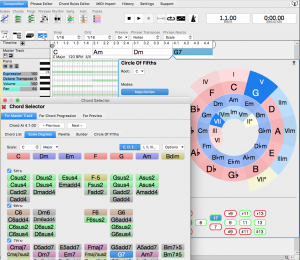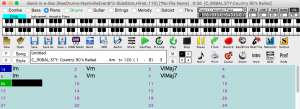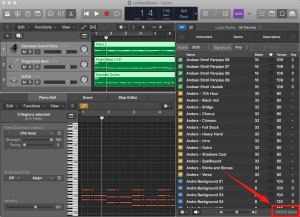Rapid Composer 3.8: The Missing Manual
1. Introduction and Overview
1.1 Music Prototyping
The term “music prototyping” refers to all preparatory compositional methods that (can) contribute to a complete work in the end.
The main purpose is to sketch, view, collect and categorize musical ideas such as
- chord progressions
- phrases
- tunes
- beats
- themes, motifs, variations
- sounds, noises
- citations
1.2 Music Prototyping Software
Music Prototyping Software supports composers in these activities. In addition, it is also able to generate entire music parts fully automatically according to given parameters. Users are then faced with the ordeal of choosing which ingredients to finally use in a given composition.
Two notable developers offering music prototyping software are
- ▹ Cognitone with the titles “Harmony Navigator” and “Synfire“
- ▹ Music Developments with the App “Rapid Composer“
Other software with music prototyping functions
With Band-In-A-Box by ▹ PG Music, a program has existed since the 80s that contains many typical features of music prototyping. In addition to the combination of countless patterns in various styles, musicians can also generate melodies, solos or entire pieces of music fully automatically with a mouse click.
EZ Keys by ▹ Toontrack is designed for musicians who need a useful piano track for their MIDI production without being able to play the piano themselves. Usually it is sufficient to enter a chord sequence and a music style as required and you will hear an acceptable keyboard accompaniment.
A modern DAW like Apple’s Logic Pro X with its 24333 (!) pre-installed loops also opens up a wide playing field for creating new compositions from ready-made elements.
1.3 Music Prototyping Software as an Add-on to a Standard DAW
A good music prototyping software is characterized by a comprehensive integration of music theory. When dealing with scales, chords, phrases, etc., the musician gains a deeper insight into musical contexts than would be the case with a conventional DAW.
Is the purchase of a music prototyping software paying off? Everyone has to answer this question for himself. In any case, the purchase alone is not enough. Creative use is preceded by a relatively time-consuming learning process.
1.4 Rapid Composer 3.8
The following chapters will explain how to work with the music prototyping software Rapid Composer 3.8.x (full version) of ▹ Music Developments. The program offers a wide range of possibilities which are not immediately apparent to the user. Since no official complete manual has been available for years, I will try to fill some information gaps here.
(Update: Version 4.0 was released in December 2020. It contains some important new features, especially the possibility of AU integration in Logic Pro X, which has long been missed by Mac users. Sometime in the future there will be an update on this site as well…)
1.5 Overview
| 2 | Getting Started |
|
| 3 | Settings, Chord Experiments |
|
| 4 | Working with Tracks and Instruments |
|
| 5 | Working with Note Events |
|
| 6 | Working with Phrases |
|
| 7 | Working with the Master Track |
|
| 8 | Structure and Transport |
|






